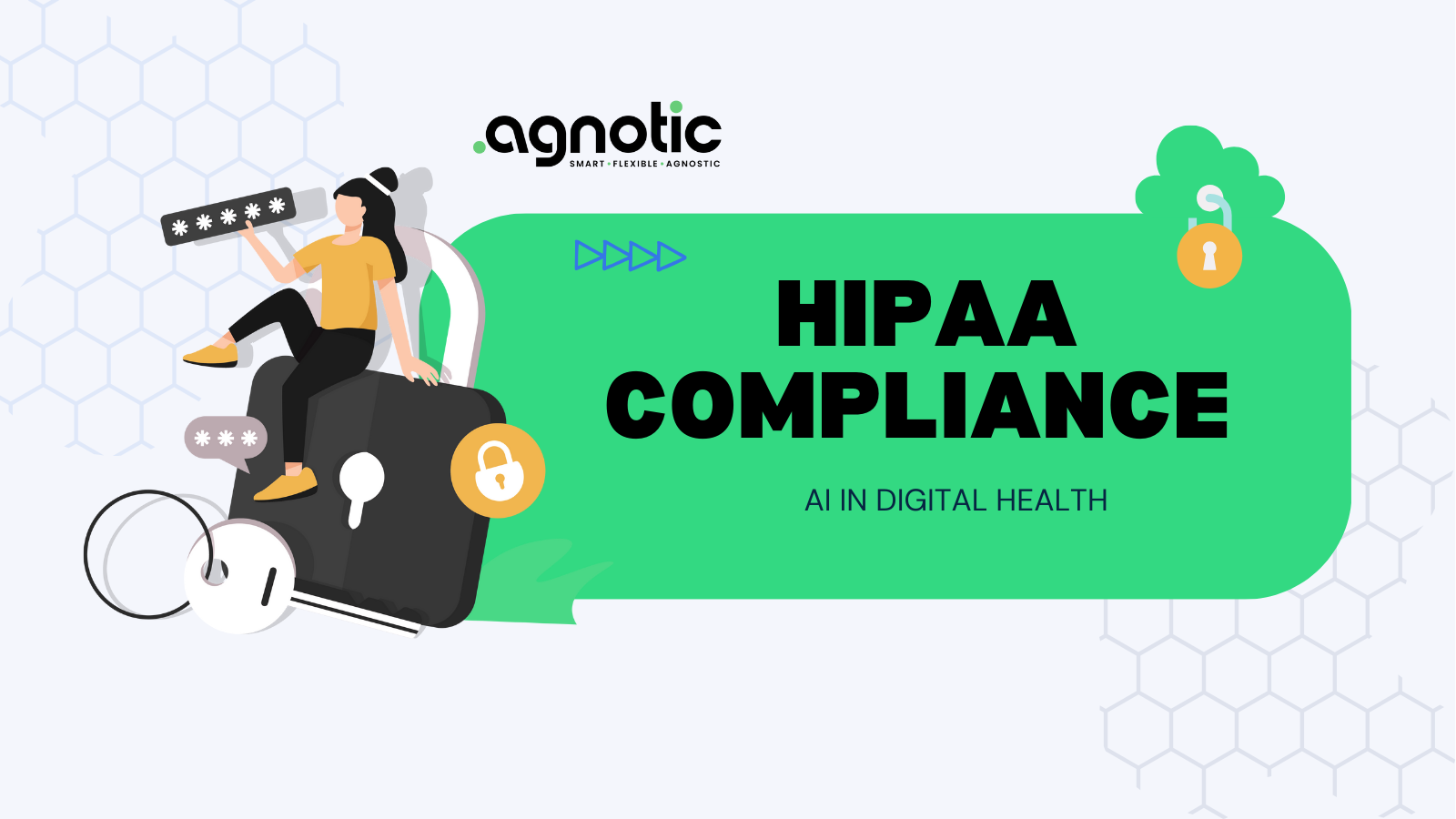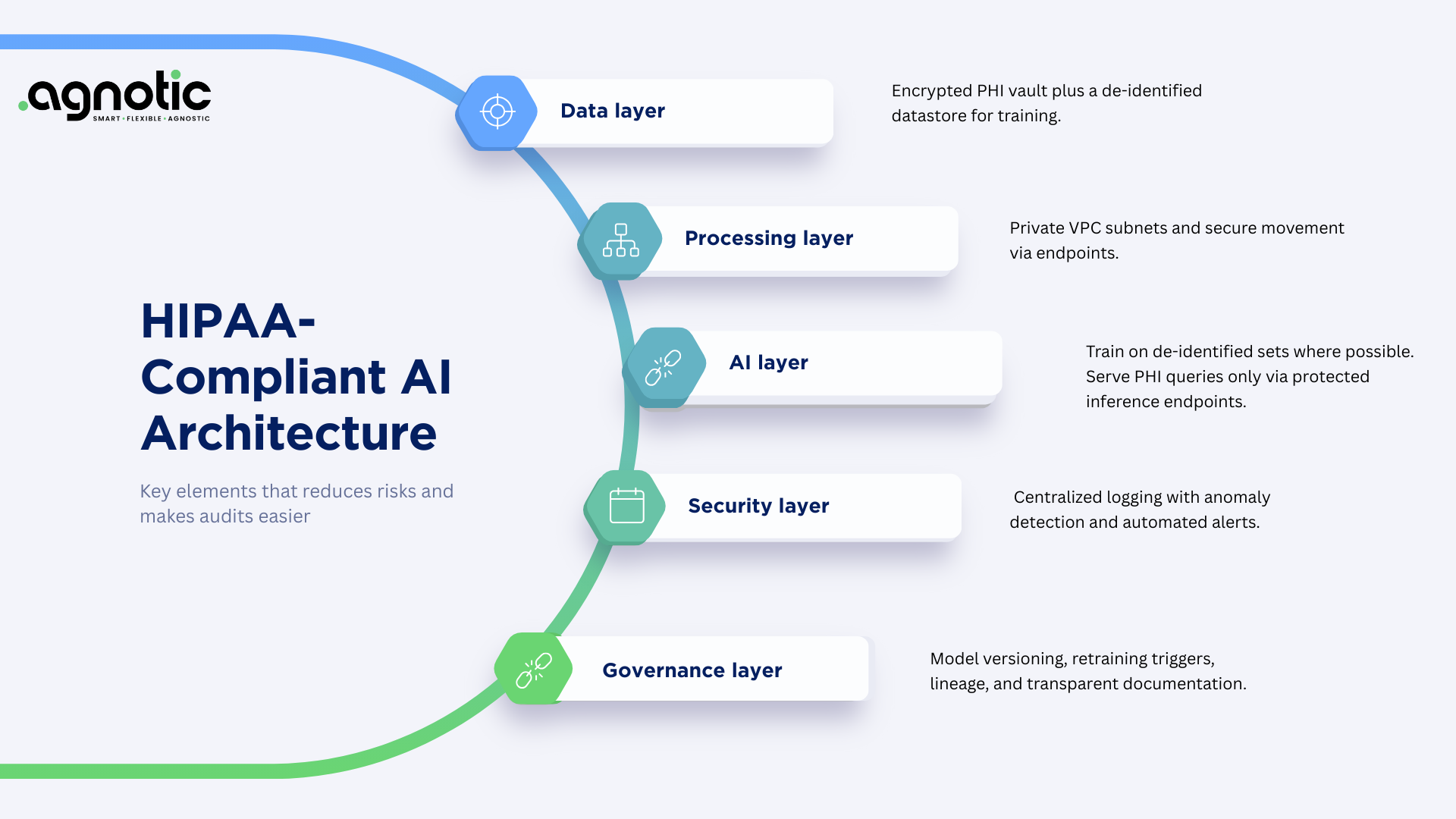HIPAA Compliant AI Software Development: The 2025 Founder’s Playbook for Healthcare Innovation




Author: Agnotic Technologies • Last updated: August 2025 • Reviewed by Security & Compliance Lead

Picture this. You’ve just finished your MVP for an AI-powered healthcare platform.
It works beautifully. The hospital innovation team nods with excitement.
Then procurement sends a 32-page Security & Compliance Questionnaire.
Half the questions are about HIPAA. A quarter are about data security.
A handful ask whether your AI model can be audited for bias and explainability.
If your answers aren’t airtight, the deal stalls. Weeks pass. Competitors catch up.
TLDR: In 2025, HIPAA-compliant AI software development is not a checkbox.
It’s your growth engine. It builds trust, shortens sales cycles, and attracts investors.
Want to test your compliance readiness early?
Start with a HIPAA-ready AI Proof of Concept
and avoid six-month stalls later.
Healthcare buyers are cautious. They’ve seen too many breaches.
Showing up with HIPAA compliance signals maturity.
Instead of waiting for IT security reviews, you move directly into pilots.
Already exploring this? See our AI development serviceswhere compliance is baked in from day one.
Early-stage teams often lose months fixing compliance after a deal stalls.
By integrating HIPAA into your product roadmap, you accelerate procurement.
Need capacity? Explore our team augmentation model for faster delivery in regulated industries.
Regulated markets scare investors. Proving HIPAA maturity shows discipline.
Include your healthcare case studies in your pitch deck to de-risk the opportunity. p>
HIPAA fines can range from $100 to $50,000 per violation (with $1.9M annual caps).
But reputational damage is worse.
Read the HIPAA Security Rule summary for regulator expectations.
Compliance is evolving rapidly. Here’s what matters in 2025:
Compliance feels overwhelming until you break it into chunks.
Here’s a 90-day roadmap founders can actually follow:
Want to test value quickly? Begin with a HIPAA-compliant AI Proof of Concept.
For production-ready assistants, explore AI agent development for clinical and patient workflows.
A well-structured architecture reduces risks and makes audits easier:
Aligned with the NIST AI Risk Management Framework to build trust with buyers and regulators.

Governance isn’t bureaucracy—it’s buyer confidence. Include:
Pixels, SDKs, and 3rd-party trackers can leak PHI.
The OCR has already penalized hospitals for using them. See HHS OCR guidance.
Best practices:
Buyers and auditors ask for the same evidence every time.
Have this ready:
Encryption is “addressable”—you must either implement it or prove an equal safeguard.
In practice, encrypt all PHI in storage and transmission.
Yes, if you meet Safe Harbor or Expert Determination standards.
But linkage attacks can still re-identify patients, so extra safeguards are common.
Yes. AWS, Azure, and GCP offer BAAs.
You must also sign with smaller analytics, hosting, or contractor vendors who can touch PHI.
Pilots can run 8–12 weeks.
Enterprise-grade platforms take 4–9 months depending on integrations and validation.
A proof of concept is the fastest start.
Predictive analytics for sepsis, AI-driven imaging triage,
patient adherence assistants, and clinical decision support tools are leading examples.
Use fairness metrics by demographic, SHAP for explainability, and drift detection dashboards.
Document retraining triggers in governance docs.
Civil fines up to $1.9M per year, plus loss of contracts.
The reputational hit can erase years of brand trust.
Only if the subcontractors sign BAAs and meet HIPAA controls.
Otherwise, it’s a violation.
If your app processes or stores PHI on behalf of covered entities, HIPAA applies.
This includes device IDs linked to patients.
An immutable record of every access, change, or transmission of PHI.
Regulators expect retention for years and quick retrieval during audits.
6-minute overview: secure data flows, model governance, procurement evidence.
HIPAA compliance isn’t just a checkbox.
Done right, it accelerates sales, builds buyer trust, and unlocks enterprise contracts.
By weaving compliance into your data architecture, AI governance, and vendor stack from day one,
you transform risk into a strategic moat.
Founders who master compliance early close deals faster, impress investors, and reduce rework.
The result: a healthcare AI product that scales smoothly in a regulated market.
We’ll map your PHI data flows, identify audit gaps, and provide a 90-day HIPAA action plan.
At Agnotic Technologies, we don’t just build software; we engineer the future of AI. As a leading native AI technology company, we specialize in developing cutting-edge AI SaaS products that accelerate innovation from ideation to final deployment. We work with enterprises and startups alike, turning complex challenges into streamlined, intelligent solutions.
Our team is dedicated to building HIPAA-ready, scalable AI platforms designed to seamlessly integrate with your existing workflow, so you can focus on what matters most: growing your business. Whether you’re looking to enhance operational efficiency, improve customer experiences, or make data-driven decisions, we’ve got the expertise to make it happen.